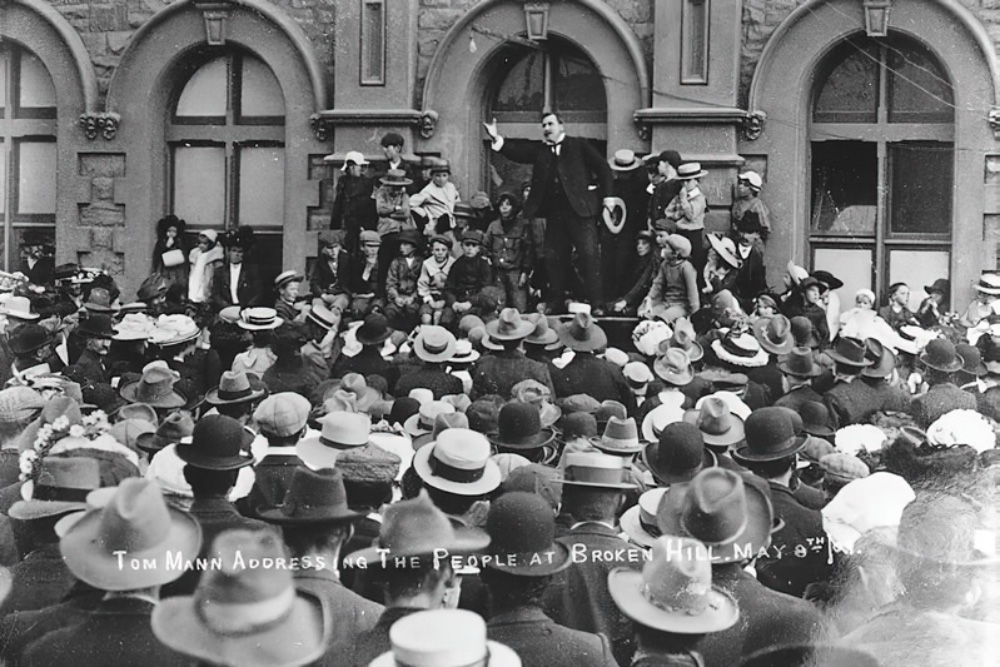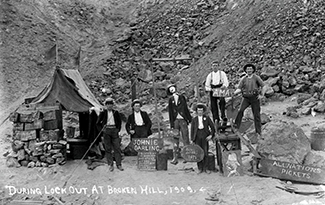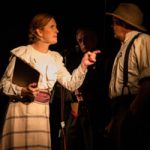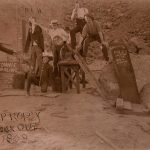


Welcome to broken hill history
EXPLORING THE STORIES OF AUSTRALIA’S FIRST HERITAGE CITY
History projects
‘United We Stand’ Heritage Performance
In this entertaining short live show, you’re invited to step back in time to May 1919, and explore the city’s mining past as you join local actors in a ‘union meeting’ of the Amalgamated Miners Association (AMA), set on the eve of the strike action that changed Australia forever. Building on previous strikes, the ‘Great Strike’ saw the community work together in solidarity for 18 months between May 1919 and November 1920 to strike against unsafe working conditions and low wages in the Broken Hill silver mines. This action remains one of the hardest-fought industrial disputes this country has ever seen. The coordinated efforts by workers and their families paved the way for better pay, safer working conditions, and a workers compensation scheme for injured workers. These agreements formed the platform for our current national WHS and Compensation Acts, and contributed to Broken Hill being named Australia’s first Nationally Heritage Listed City in 2015. ‘United we stand’ tourist play was commissioned for the Indian Pacific off-train experiences by Journey Beyond, and has been seen by around 10,000 passengers since it’s inception in April 2017? The show has since been performed by an increasing number of local actors who have helped highlight this important part of our local and national heritage. The shows have now been performed in the community at events including the Broken Hill Heritage Festival ‘Heritage Highlighted’ event, Mundi Mundi Bash fringe in town square, and to open a concert in Trades Hall. In addition, the success of the show lead to a successful NSW Government Heritage Grant, ‘United We Stand: Strikes Scabs & Solidarity in Broken Hill’, which saw the concept expanded to include the development of props and costumes to produce Augmented Reality Postcards featuring recreations of the 1909 Lockout and early Picnic Days. For more information contact UWS@brokenhillhistory.com Download the script [LINK / download]View photo gallery [LINK to gallery]
Strikes, Scabs and Augmented Reality in Broken Hill
Postcards were the ‘Social Media’ of years gone by. See history come to life through the development of reproduction props, costumes, and Augmented Reality Postcards inspired by famous Broken Hill postcard photographs featuring short video clips produced locally for ‘United We Stand: Strikes Scabs and Solidarity in Broken Hill’. INSERT PIC OF one or two ACTUAL POSTCARDS OF GRAVES In the early years of Broken Hill, it was common for people to reproduce postcards to share with the community. This was done for a number of reasons. Some of the most famous examples of Broken Hill postcards were the images of mock graves and campsites captured and shared during the militant 1909 Lockout and early Picnic Days. In the lockout, Tom Mann famously unionised the workforce and helped convince the workers of BHP to strike for better wages. He then took the postcards to England to assist motivating workers to join the cause for solidarity in the labour movement there. Caption: some of the crew who helped bring history to life. Film shoot in Dec 2021. About the Project: Based on the successful United We Stand Tourist play, funding was secured for a NSW Government Heritage Grant to develop United We Stand: Strikes Scabs & Solidarity in Broken Hill, which included the development of props and costumes to produce Augmented Reality Postcards featuring recreations of several postcards from this period. The final postcards produced focussed on the early unionisation period of Broken Hill’s history and feature two postcards from the 1909 lockout and one of a picnic in a creek bed in 1908. In addition to recreating mock graves and costumes from the period, we were able to incorporate Augmented Reality experience to bring history to life. Th post cards are for sale at selected museums as a fundraising initiate to help these vital community resources. Check out ‘Outback Museum Stories’ to find out more about Broken Museum experiences. How it works: By scanning the QR code you can access the technology to hold a mobile device over the video to watch a video as the post card has come to life. Read on for examples of the postcards as well as the reference images and videos created. Picnic Day 1909 Lockout Effigy 1909 Lockout Mock Graves
broken hill history stories
- Postcard Stories

Tom Mann the Social activist from Great Britain addressed the Women’s League on Wednesday 14th October, 1908 urging them to ‘resist any lowering of the standard of living on the Barrier, and calling upon the men to claim the half-holiday as a reasonable concession’ to their demands in the Award negotiations due for review in December. The crowds in the Trades Hall overflowed and he had to address a mixed audience and repeat his speech outside. You will note the number of children and families in attendance. His next speech on Monday October 19th, dealt with the importance of Industrial action to fight a Class war against the capitalist Mining Companies. The AMA invited Tom Mann and Lizzie Ahern to address a mass meeting at the outbreak of the strike. He delivered a speech on January 8th 1909 that incited women to lead the procession against the police and scabs the following day. A violent street battle ensued, during which Tom Mann and twenty seven male protesters were arrested. Thousands of townsfolk encamped around the gaol. Most of the protesters were acquitted or fined, some served short sentences. Tom Mann was released on a bond not to make speeches in…

Ill feeling toward the Broken Hill Proprietary Company ran high during the days when workers were locked out from the field. Since the NSW Arbitration Act of 1901, all negotiations had to be through the Courts. The following year BHP cut wages by 10% and two thousand miners left for other fields. In 1903, Justice Cohen refused to vary the 1893 agreement, freezing wages and introducing two-week contracts for underground workers. The town population dropped by 5,000 people. In 1906, the AMA elected by secret ballot to negotiate directly with Mr G.D. Delprat, General Manager of BHP. He attended the Trades Hall as a ‘private citizen’ and as a result the MMA and AMA agreed on the first wage rise in 13 years1. The 12.5% lead bonus would be paid until December 1908. By then the mineral prices had again plummeted and John Darling, the new head of BHP, refused to honour the previous agreement and withdrew from Arbitration. The miners regarded the dispute as a ‘Lock Out’, the MMA regarded it as a strike. The startling effigy of John Darling of the Broken Hill Propriety Company was not a first for the mining field. In the drought of 1888,…


